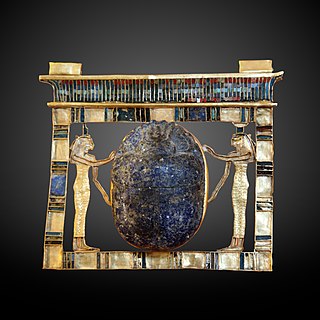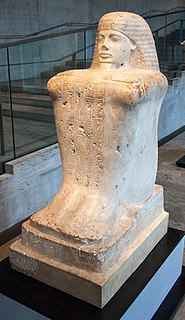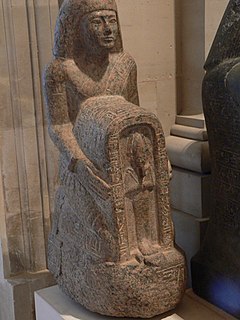Related Research Articles

In early Egyptian mythology, Anhur was a god of war who was worshipped in the Egyptian area of Abydos, and particularly in Thinis. Myths told that he had brought his wife, Mehit, who was his female counterpart, from Nubia, and his name reflects this—it means (one who) leads back the distant one.

Nefertari, also known as Nefertari Meritmut, was an Egyptian queen and the first of the Great Royal Wives of Ramesses the Great. Nefertari means 'beautiful companion' and Meritmut means 'Beloved of [the goddess] Mut'. She is one of the best known Egyptian queens, next to Cleopatra, Nefertiti, and Hatshepsut. She was highly educated and able to both read and write hieroglyphs, a very rare skill at the time. She used these skills in her diplomatic work, corresponding with other prominent royals of the time. Her lavishly decorated tomb, QV66, is one of the largest and most spectacular in the Valley of the Queens. Ramesses also constructed a temple for her at Abu Simbel next to his colossal monument there.

The necropolis of El-Khokha is located on the west bank of the river Nile at Thebes, Egypt. The necropolis is surrounds a hill and has five Old Kingdom tombs and over 50 tombs from the 18th, 19th and 20th dynasties as well as some from the First Intermediate Period and the Late Period.
Amenemope, also Amenemopet, Amenemipet or Amunemopet(ỉmn-m-ỉp3.t, Greek: αμενωφις; “Amun in Luxor”) is an Ancient Egyptian name. Its notable bearers were:

The High Priest of Amun or First Prophet of Amun was the highest-ranking priest in the priesthood of the ancient Egyptian god Amun. The first high priests of Amun appear in the New Kingdom of Egypt, at the beginning of the Eighteenth Dynasty.

The Ancient Egyptian Noble Paser was vizier, in the reigns of Seti I and Ramesses II, during the 19th dynasty. He would later also become High Priest of Amun.

Bakenkhonsu was a High Priest of Amun in ancient Egypt during the reign of Pharaoh Ramesses II. Information about his life was found on the back of his block statue. The information on the statue provides details about the education of young Egyptian noblemen at that time and the career of priests.
Paser II was the son of the High Priest of Min and Isis named Minmose. Paser came from a very well-connected family. One uncle was the High Priest of Amun Wennenefer and another uncle was the troop commander of Kush named Pennesuttawy. Through Wennenefer, Paser was related to Amenemone, Amenemope and Hori, the High Priest of Anhur.
Paser I was the Viceroy of Kush during the reigns of Ay and likely Horemheb. Reisner mentions that the only datable inscriptions for Paser belong to the reign of Ay. The next known Viceroy however is Amenemopet, who is dated to the reign of Seti I. Hence it's possible that Paser I served during the reigns of Ay, Horemheb

Menkheperreseneb II was a High Priest of Amun, Superintendent of the Gold and silver treasuries, and Chief of the Overseers of Craftsmen. He served at the time of Thutmose III and Amenhotep II, and may have been buried in his Theban tomb, TT112.
Nebwenenef was High Priest of Amun at the beginning of the reign of Ramesses II during the 19th Dynasty. Prior to that, Nebwenenef had served as High Priest of Anhur and High Priest of Hathor during the reign of Seti I and possibly even earlier.
Parennefer also called Wennefer was a High Priest of Amun during the reigns of Tutankhamen and Horemheb. He was previously thought to date to the time of Ramesses II, but he is now dated to the end of the Eighteenth Dynasty. Parennefer was more firmly put at the end of the Eighteenth Dynasty after extensive excavations of his tomb in Thebes in 1990-1993.
The High Priest of Ra or of Re was known in Egyptian as the wr-mꜢw, which translates as Greatest of Seers.

The Theban Tomb TT58 is located in Sheikh Abd el-Qurna, part of the Theban Necropolis, on the west bank of the Nile, opposite to Luxor. The tomb was originally carved for a courtier dating to the time of Amenhotep III and later usurped during the Ramesside period.
Pennesuttawy was a Military Commander and Superintendent of the Southern Lands (Kush) during the beginning of the Nineteenth Dynasty of Egypt.

Wenennefer was an ancient Egyptian High Priest of Osiris at Abydos, during the reign of pharaoh Ramesses II of the 19th Dynasty.

Yuyu was an ancient Egyptian High Priest of Osiris at Abydos, during the reign of pharaohs Ramesses II and possibly Merenptah of the 19th Dynasty.
Minmose was the High Priest of Anhur during the reign of Ramesses II
Nakhtmin or Minnakht is the name of several Ancient Egyptian Officials
Qeni was the Superintendent of the Granary during the reign of Ramesses II. Qeni and his family came from Asyut.
References
- 1 2 3 4 5 6 7 8 9 Kitchen, K.A., Ramesside Inscriptions, Translated & Annotated, Translations, Volume III, Blackwell Publishers, 1996, pg 209, 193-195, 315
- 1 2 3 Peter Pamminger, Hori, Hoherpriester des Amun, The Journal of Egyptian Archaeology, Vol. 85 (1999), pp. 226-230, Egypt Exploration Society, Stable URL: https://www.jstor.org/stable/3822440
- ↑ Kampp, F., and K. J. Seyfried, Eine Rückkehr nach Theben, Antike Welt, Mainz 26 (1995), 325-342. (ill. incl. colours, plans).
- ↑ Kampp-Seyfried, Friederike, Die Verfemung des Namens pA-rn-nfr, in: Stationen. R. Stadelmann gewidmet, 303-319. (pl.).
- ↑ Kampp, F., Vierter Vorbericht über die Arbeiten des Ägyptologischen Instituts der Universität Heidelberg in thebanischen Gräbern der Ramessidenzeit, MDAIK 50 (1994), 175-188. (fig., plans, pl.).